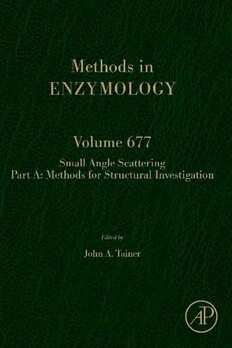
Small Angle Scattering Part A: Methods for Structural Investigation PDF
Preview Small Angle Scattering Part A: Methods for Structural Investigation
VOLUMESIXHUNDRED AND SEVENTYSEVEN M ETHODS IN ENZYMOLOGY Small Angle Scattering Part A: Methods for Structural Investigation METHODS IN ENZYMOLOGY Editors-in-Chief ANNA MARIE PYLE Departments of Molecular, Cellular and Developmental Biology and Department of Chemistry Investigator, Howard Hughes Medical Institute Yale University DAVID W. CHRISTIANSON Roy and Diana Vagelos Laboratories Department of Chemistry University of Pennsylvania Philadelphia, PA Founding Editors SIDNEY P. COLOWICK and NATHAN O. KAPLAN VOLUMESIXHUNDRED AND SEVENTYSEVEN M ETHODS IN ENZYMOLOGY Small Angle Scattering Part A: Methods for Structural Investigation Edited by JOHN A. TAINER Robert A. Welch Chair in Chemistry Departments of Molecular & Cellular Oncology and of Cancer Biology Director Structural Biology University of Texas MD Anderson Cancer Center Houston, TX AcademicPressisanimprintofElsevier 50HampshireStreet,5thFloor,Cambridge,MA02139,UnitedStates 525BStreet,Suite1650,SanDiego,CA92101,UnitedStates TheBoulevard,LangfordLane,Kidlington,OxfordOX51GB,UnitedKingdom 125LondonWall,London,EC2Y5AS,UnitedKingdom Firstedition2022 Copyright©2022ElsevierInc.Allrightsreserved. Nopartofthispublicationmaybereproducedortransmittedinanyformorbyanymeans,electronic ormechanical,includingphotocopying,recording,oranyinformationstorageandretrievalsystem, withoutpermissioninwritingfromthepublisher.Detailsonhowtoseekpermission,further informationaboutthePublisher’spermissionspoliciesandourarrangementswithorganizationssuch astheCopyrightClearanceCenterandtheCopyrightLicensingAgency,canbefoundatourwebsite: www.elsevier.com/permissions. Thisbookandtheindividualcontributionscontainedinitareprotectedundercopyrightbythe Publisher(otherthanasmaybenotedherein). Notices Knowledgeandbestpracticeinthisfieldareconstantlychanging.Asnewresearchandexperience broadenourunderstanding,changesinresearchmethods,professionalpractices,ormedical treatmentmaybecomenecessary. Practitionersandresearchersmustalwaysrelyontheirownexperienceandknowledgeinevaluating andusinganyinformation,methods,compounds,orexperimentsdescribedherein.Inusingsuch informationormethodstheyshouldbemindfuloftheirownsafetyandthesafetyofothers,including partiesforwhomtheyhaveaprofessionalresponsibility. Tothefullestextentofthelaw,neitherthePublishernortheauthors,contributors,oreditors,assume anyliabilityforanyinjuryand/ordamagetopersonsorpropertyasamatterofproductsliability, negligenceorotherwise,orfromanyuseoroperationofanymethods,products,instructions,orideas containedinthematerialherein. ISBN:978-0-323-99179-7 ISSN:0076-6879 ForinformationonallAcademicPresspublications visitourwebsiteathttps://www.elsevier.com/books-and-journals Publisher:ZoeKruze DevelopmentalEditor:FedericoPauloS.Mendoza ProductionProjectManager:SudharshiniRenganathan CoverDesigner:GregHarris TypesetbySTRAIVE,India Contents Contributors xi Preface xv 1. Advanced sampleenvironmentsandsample requirements for biologicalSAXS 1 Melissa A.Graewert andDmitri I.Svergun 1. Introduction 2 2. Correlationbetweenthephysicalprocessofthescatteringeventand samplerequirements 4 3. Automatedsampleloadingrobotics 14 4. Couplingofonlinepurificationsystems 21 5. Specializedsampleenvironments 30 References 35 2. Contrastvariation SAXS: Sample preparation protocols, experimental procedures, and data analysis 41 JosueSanEmeterio, SuzetteA. Pabit, andLois Pollack 1. Introduction 42 2. Background:SAXSandCV-SAXS 44 3. WhatinformationcanbeextractedfromCV-SAXSdata? 49 4. Experimentalconsiderations 53 5. Doingtheexperiment 62 6. Examplesofinformationextracted 65 7. Conclusionsandoutlook 77 Acknowledgments 77 References 78 3. Deuteration for biological SANS: Case studies,success and challenges inchemistry andbiology 85 Anthony P.Duff,Marina Cagnes, TamimA. Darwish, AnwenM. Krause-Heuer, MichaelMoir, CarlRecsei, AgataRekas, RobertA. Russell,Karyn L.Wilde, and NageshwarR.Yepuri 1. Deuterationforsmallangleneutronscattering 87 2. ProteinSANS 92 3. Membranes:Sterolsandphysiologicallyrelevantlipids 100 v vi Contents 4. Deuterationbychemicalsynthesis 100 5. Examplesofusesofdeuterationforneutronscattering 105 6. Deuterationfacilities 106 7. Deuterationfacilityuse:Costs,feasibility,andqualityoftheexperiment 107 8. ThenamingofIsotopologues:Aproblemforstructuralbiologists,industry, anddatabases 109 9. Proposalsfortheregistrationofdeuteratedcompounds 120 10. Concludingremarks 120 References 121 4. Planning,executing and assessing the validityof SANS contrast variation experiments 127 SusanKrueger 1. Introduction 128 2. Experimentplanning 132 3. Datacollectionandassessmentofvalidity 142 4. Furtherdataanalysisandmodelrefinement 147 5. Concludingremarks 151 Acknowledgments 151 Disclaimer 151 References 151 5. Technicalconsiderationsforsmall-angleneutronscatteringfrom biologicalmacromoleculesinsolution:Crosssections,contrasts, instrument setup and measurement 157 ZuzannaPietras, KathleenWood, Andrew E.Whitten, andCy M. Jeffries 1. Introduction 158 2. Nuclearcrosssections 159 Notes 171 3. Smallangleneutronscatteringinstruments 171 4. Themeasurementapproach 179 5. Summary 185 Acknowledgments 186 References 187 6. Size exclusionchromatography coupled small angle X-ray scatteringwithtandemmultianglelightscatteringattheSIBYLS beamline 191 DanielJ. Rosenberg, GregL.Hura, andMichal Hammel 1. Introduction 192 2. Endstationdesign 193 Contents vii 3. SamplepreparationforSEC-SAXS-MALS 198 4. Dataacquisition 202 5. Dataprocessing 207 6. Datavalidationandanalysis 210 7. Summaryandconclusion 214 Acknowledgments 215 References 215 7. SEC-SAXS:Experimentalset-upandsoftwaredevelopmentsbuild upa powerful tool 221 JavierP(cid:1)erez, Aur(cid:1)elien Thureau, andPatrice Vachette 1. Introduction 222 2. Theinstrument 223 3. Dataprocessing 231 4. ComparativeanalysisofSEC-SAXSdatasetsusingthevariousavailable programs 238 5. Conclusion 245 Acknowledgments 247 References 247 8. Stopped-flow-time-resolved SAXS for studiesofligand-driven protein dimerization 251 HenningTidowand Inokentijs Josts 1. Introduction 252 2. Samplepreparation 254 3. Stopped-flowexperiment:Themeasurement 255 4. Dataanalysisandinterpretation 257 5. SingularvaluedecompositionandOLIGOMERanalysisoftime-resolved SAXSdata 258 6. FittingakineticmodeltoextractrateconstantsfromSF-SAXSdata 260 7. Summaryandconclusions 260 Acknowledgments 260 References 260 9. Time-resolved small-angle neutronscattering (TR-SANS)for structural biology of dynamic systems:Principles, recent developments, andpracticalguidelines 263 AnneMarteland Frank Gabel 1. Introduction,principlesandlimitations 264 2. Examplesfromdiverseclassesofbiologicalsystems 271 viii Contents 3. ConsiderationsonsamplestateandpracticalguidelinesforthedesignofTR- SANSexperiments 275 4. Conclusionsandfutureperspectives 281 Acknowledgment 283 References 283 10. Protein fibrillation from another small angle: Sample preparation andSAXSdata collection 291 Bente Vestergaard and AnnetteEvaLangkilde 1. Introduction 292 2. Generalmethodandsafetynotes 297 3. Feasibility,designandoptimization 299 4. Themainexperiment:SAXSdatacollection 309 5. Summaryandconclusions 316 Acknowledgments 317 References 317 11. High-pressureSAXS, deep life, andextremebiophysics 323 Richard E. Gillilan 1. Introduction 324 2. Structuraleffectsofpressureonbiomolecularsystems 325 3. PressuredependenceofSAXS 332 4. Methods 340 5. Summaryandconclusions 348 Acknowledgments 350 References 350 12. Characterizationof biological materials with soft X-ray scattering 357 Joshua T.Del Mundo,Sintu Rongpipi,Enrique D.Gomez, and Esther W.Gomez 1. Introduction 358 2. Samplepreparationfordryordehydratedmaterials 363 3. Samplepreparationforliquidsandhydratedsolids 367 4. Storingandtransportingsamples 369 5. Mountingsamplesontoasamplebar 370 6. PerformingNEXAFSexperiments 372 7. PerformingRSoXSexperiments 374 8. OpportunitiesininstrumentationforresonantsoftX-rayscatteringof biologicalsystems 379 Contents ix 9. Conclusionandoutlook 380 Acknowledgments 380 References 381 13. Scattering measurementson lipid membrane structures 385 Lin Yang 1. Introduction 385 2. Informationcontentsinthescatteringdata 387 3. Generalexperimentalplanningconsiderations 391 4. Biologicalmembranes 394 5. Modelmembranestructures 396 6. Concludingremarks 409 References 410 14. Studying integral membraneprotein bySANS using stealth reconstitutionsystems 417 Inokentijs Josts, Dominique-Maurice Kehlenbeck,Julius Nitsche, and Henning Tidow 1. Introduction 418 2. Contrastvariationinsmall-angleneutronscattering(SANS)byselective deuterationoflipidsandproteinsforuseasstealthcarriersystems 420 3. Reconstitutionofintegralmembraneproteins(IMP)intostealthcarrier systems/example:ReconstitutionofMsbAintostealthnanodiscs 423 4. SANSdataacquisitionandanalysisofIMP/stealthnanodiscsamples 428 5. Summaryandconclusions 429 Acknowledgments 429 References 430 15. Predicting solution scattering patternswith explicit-solvent molecular simulations 433 LeonieChatzimagas and JochenS. Hub 1. Introduction 434 2. Implicit-solventmethods 437 3. Explicit-solventSASpredictionswiththeWAXSiSmethod 441 4. Theory 444 5. Workflow 446 6. Practicalconsiderations 450 7. Summary 452 Acknowledgments 453 References 453
